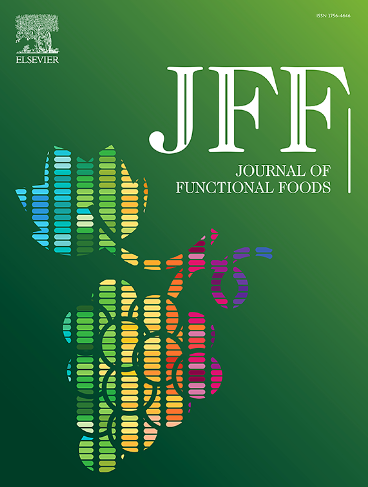基于UPLC-MS、网络药理学和实验验证的何首乌饮片干预2型糖尿病的有效成分及分子机制研究
IF 4
2区 农林科学
Q2 FOOD SCIENCE & TECHNOLOGY
引用次数: 0
摘要
黄精饮料(PSB)是一种降糖功能饮料,根据医书《妙永黄经止白冰》中的配方制成。然而,其有效成分和分子机制尚不清楚。本研究旨在通过超高效液相色谱-质谱(UPLC-MS)、网络药理学和实验验证等手段,探讨PSB对2型糖尿病(T2DM)的治疗作用机制。UPLC-MS鉴定了77个PSB化合物,网络药理学预测了318个潜在的t2dm相关靶点。鉴定出主要有效成分为威纳醇内酯A、醋酸金酰胺和n -反式阿魏lotopamine。PSB治疗降低了T2DM小鼠的空腹血糖,改善了血脂(TC、TG、HDL-C、LDL-C),减轻了肝脏和胰腺损伤。RT-qPCR分析显示,PSB上调JUN、JAK2、MAPK3和GSK-3β,下调PI3K、AKT1。PSB调节AGE-RAGE和PI3K-AKT通路。提示PSB对T2DM的治疗是通过多组分、多靶点、多通路机制发挥作用的。本文章由计算机程序翻译,如有差异,请以英文原文为准。

Study on the active ingredients and molecular mechanisms of Polygonatum sibiricum beverage in the intervention of type 2 diabetes mellitus based on UPLC-MS, network pharmacology and experimental validation
Polygonatum sibiricum beverage (PSB), a functional beverage with hypoglycaemic effects, is based on a formula from the medical book Miao Yong Huangjing Zhi Bai Bing. However, its active ingredients and molecular mechanisms remain unclear. This study aimed to elucidate the mechanisms by which PSB exerted its therapeutic effects on type 2 diabetes mellitus (T2DM) using Ultra Performance Liquid Chromatography-Mass Spectrometry (UPLC-MS), network pharmacology, and experimental validation. UPLC-MS identified 77 compounds in PSB, and network pharmacology predicted 318 potential T2DM-related targets. Key active ingredients, including Withanolide A, Aurantiamide acetate, and N-trans-Feruloyloctopamine, were identified. PSB treatment reduced fasting blood glucose, improved serum lipid profiles (TC, TG, HDL-C, LDL-C), and alleviated liver and pancreatic damage in T2DM mice. RT-qPCR analysis showed that PSB upregulated JUN, JAK2, MAPK3, and GSK-3β, and downregulated PI3K, AKT1. PSB regulated AGE-RAGE and PI3K-AKT pathways. These results suggested that PSB exerted therapeutic effects on T2DM through multi-component, multi-target and multi-pathway mechanisms.
求助全文
通过发布文献求助,成功后即可免费获取论文全文。
去求助
来源期刊

Journal of Functional Foods
FOOD SCIENCE & TECHNOLOGY-
CiteScore
9.60
自引率
1.80%
发文量
428
审稿时长
76 days
期刊介绍:
Journal of Functional Foods continues with the same aims and scope, editorial team, submission system and rigorous peer review. We give authors the possibility to publish their top-quality papers in a well-established leading journal in the food and nutrition fields. The Journal will keep its rigorous criteria to screen high impact research addressing relevant scientific topics and performed by sound methodologies.
The Journal of Functional Foods aims to bring together the results of fundamental and applied research into healthy foods and biologically active food ingredients.
The Journal is centered in the specific area at the boundaries among food technology, nutrition and health welcoming papers having a good interdisciplinary approach. The Journal will cover the fields of plant bioactives; dietary fibre, probiotics; functional lipids; bioactive peptides; vitamins, minerals and botanicals and other dietary supplements. Nutritional and technological aspects related to the development of functional foods and beverages are of core interest to the journal. Experimental works dealing with food digestion, bioavailability of food bioactives and on the mechanisms by which foods and their components are able to modulate physiological parameters connected with disease prevention are of particular interest as well as those dealing with personalized nutrition and nutritional needs in pathological subjects.
 求助内容:
求助内容: 应助结果提醒方式:
应助结果提醒方式:


